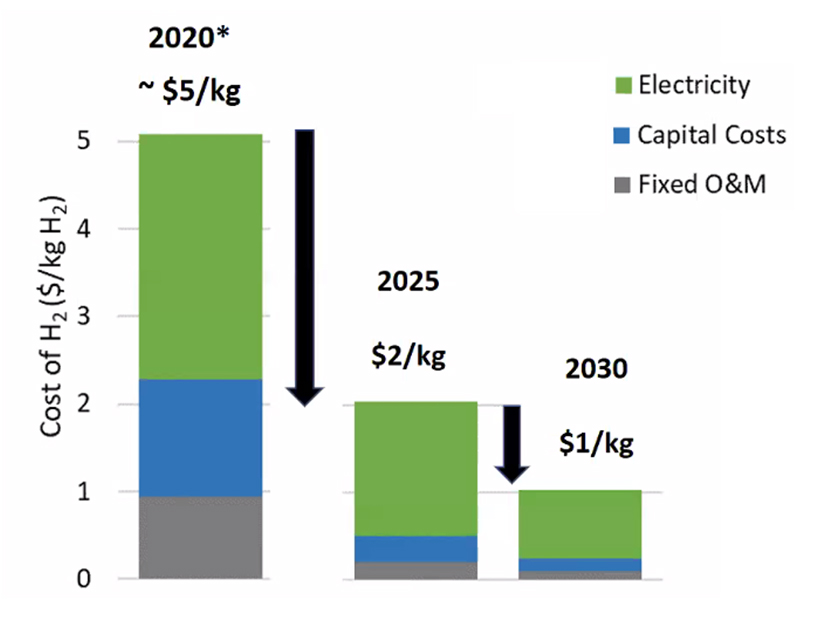The opening session of the Department of Energy’s Hydrogen Shot Summit provided a fast and furious overview of the critical role hydrogen could play in the global energy transition and the current state of the U.S. domestic supply chain, with a focus on the DOE’s goal of cutting the price of green hydrogen to $1/kg by 2030.

Opening the summit, Energy Secretary Jennifer Granholm framed that target as a vital component of President Biden’s plans to decarbonize the U.S. electric system by 2035 and build out a net-zero economy by 2050.
“If we can lower the cost of clean hydrogen, and I truly mean clean, to $1 for one kilogram at the same time as we eliminate GHG emissions, we will have the means to decarbonize industrial manufacturing, to refuel hydrogen fuel cell trucks, make alternative low-carbon fuel for planes, produce clean ammonia and other chemicals, create longer duration storage, and so much more,” Granholm said.
The packed agenda — featuring keynotes by Special Presidential Envoy John Kerry, Bill Gates and Sen. Joe Manchin (D-W. Va), along with three “lightening round” stakeholder panels — all reinforced Granholm’s main messages.
Key among them: hydrogen can fill the gaps in clean power production that even rapid deployment of solar and wind cannot meet; broad public-private collaboration will be essential to commercialize and scale the technology at a pace that will ensure U.S. competitiveness and leadership in global markets.

“More than 90% of all future emissions will come from outside our borders,” Kerry said. “That means that in addition to reducing emissions at home, our ability to tackle the climate crisis will require America to speed the global net-zero transition. The most high-leverage way that we have to do that is through innovation, driving down the cost to critical clean technologies that can be scaled up and deployed around the world.”
Manchin used his time to promote the bipartisan infrastructure package, which includes provisions he authored that will fund the development of green hydrogen processes using renewable energy, nuclear power and natural gas with carbon capture.
“We need to invest in the entire hydrogen value chain to bring down the cost and overcome deployment barriers,” Manchin said, pointing to the $9.5 billion in the infrastructure bill to be used for research, development and demonstration of clean hydrogen. The bill would also advance the creation of hydrogen hubs to “accelerate hydrogen production from all energy sources and facilitate its delivery and use across all sectors of the economy,” he said.

But Microsoft founder Bill Gates cautioned that the innovation ahead may not follow any one path.
“There are many different ideas, and we’ll have to try out different things. We’ll have to see how things work as we scale up,” Gates said. Breakthrough Energy Ventures, Gates’s climate investment fund, recently announced a partnership with the DOE that will provide $1.5 billion in funding to support demonstration projects in green hydrogen, as well as sustainable aviation fuel, direct air capture and long-duration storage.
The funding is conditioned on the passage of the bipartisan infrastructure package, but Gates said, “Through blended finance we’ll find a way to decrease the cost of these products and make them available on the market, proving they can be financed and scaled up.”
Gray, Blue and Green
The way to green hydrogen — powered by renewable energy such as wind, solar or nuclear — must go first through gray and blue hydrogen, produced from natural gas (gray) or natural gas with carbon capture (blue), said Seifi Ghasemi, CEO of Air Products, a global natural gas and natural gas equipment supplier.
With the cost of green hydrogen still at about $5/kg, the more traditional and affordable technologies are a key part of his company’s business, Ghasemi said during a stakeholder panel of hydrogen producers. Air Products is building a green hydrogen project in Saudi Arabia, which will use an estimated 4 GW of solar, wind and storage to produce 650 tons of green hydrogen per day, according to the company’s website.

“The reason we did it over there was because it was the fastest location that we could bring those things together,” he said. “The point of all these things we are talking about — bringing the cost down — you can only do that if you actually do it. We had to start somewhere.”
A green hydrogen supply chain is emerging, according to other industry representatives on the panel, with different, transitional technologies. Air Liquide has a hydro-powered facility in Quebec, Canada, and a project in Nevada that will initially produce hydrogen from renewable natural gas — using biogas or landfill gas — to supply hydrogen fuel cell vehicles on the West Coast, said Executive Vice President Michael Graff.
Plug Power, on the other hand, is building out a “green hydrogen ecosystem,” said Chief Strategy Officer Sanjay Shrestha. The company provides electrolyzers to produce green hydrogen and fueling stations for both mobile and stationary applications, according to its website.

Expanding applications for green hydrogen means costs will come down, Shrestha said, which will, in turn, create more demand for green hydrogen. “And how wonderful is it that we are really looking at leveraging low-cost, domestically produced renewable electricity and turning that into your high-value green hydrogen fuel so that you can really go out and displace diesel,” he said.
The claims for blue hydrogen as a low-carbon energy source have raised debate among some clean tech advocates. A recent paper from researchers at Cornell and Stanford universities attacked blue carbon for the “fugitive emissions” that may escape carbon capture technologies, arguing that such emissions could be worse than the greenhouse gases produced by burning gas to heat homes or power industrial processes.
Granholm acknowledged the controversy but said that the Hydrogen Shot will be “all about science. We’re all about zero carbon emissions, and we also clearly need to reduce other pollutants like [nitrogen oxide]. If there are solutions that claim to be clean, but are not, those challenges have to be addressed. We want honest, data-driven answers in our quest for affordable, clean energy.”



